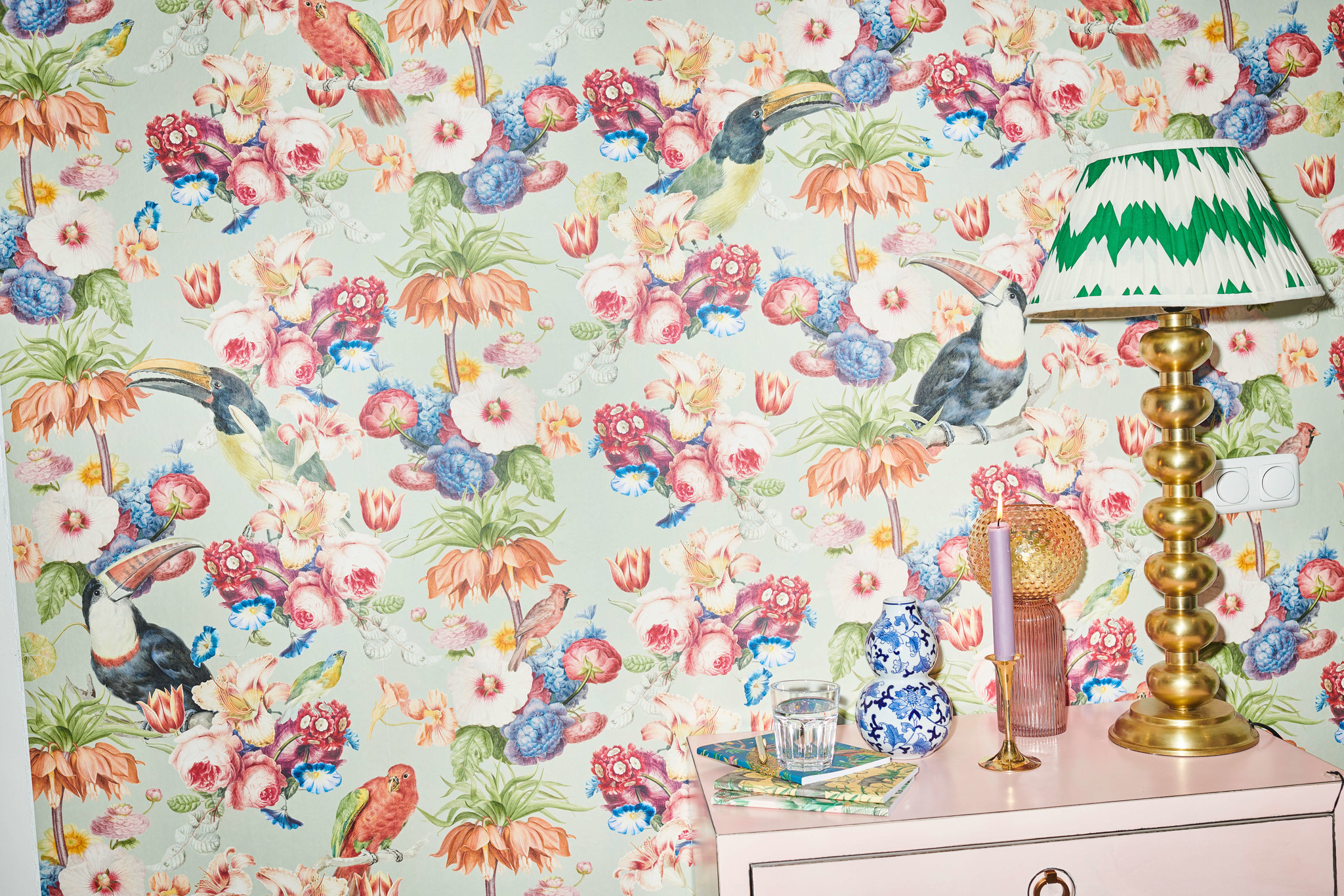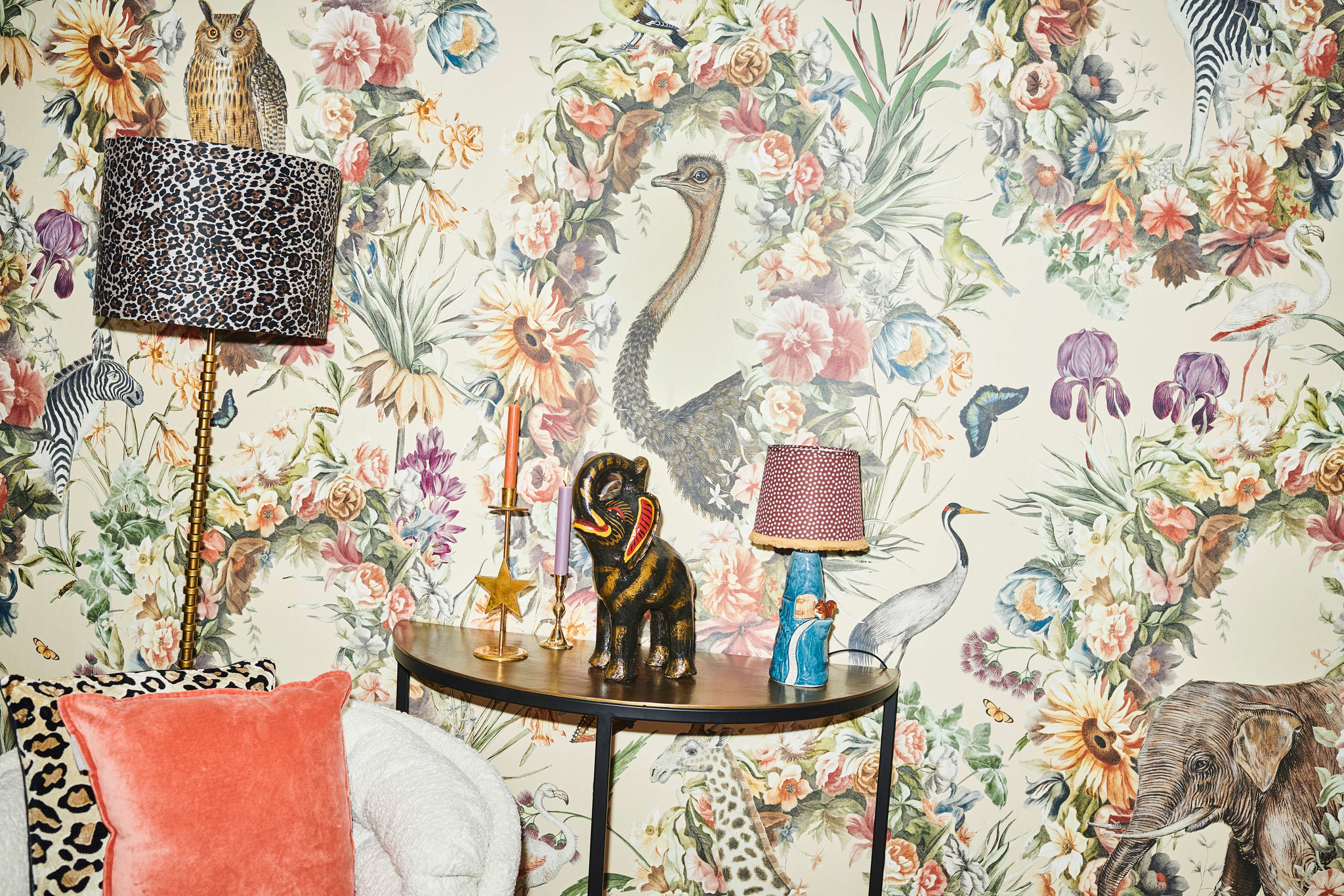The designs of the Rijksmuseum wallpaper collection were created with works of different masters of the 1500 -1800 centuries. Each of these masters have their own story that must be continued to be told. We have highlighted a number of masters for each design referring to elements that were used in that design. This is how stories will be continued to be told.
 Finely drawn flower and animal figures of drawings and paintings of Dorothea Maria Gsell born in the 17th century, Jean Bernard form the 19th century and Robert Jacob Gordon from the 18th century have been combined and have led to a new imaginative and fabulous design. Each artist had their own fascination of flora and fauna that they have captured in their drawings and paintings. This way the stories of the past create a design of the future and it will get a place in the spotlights once again.
Finely drawn flower and animal figures of drawings and paintings of Dorothea Maria Gsell born in the 17th century, Jean Bernard form the 19th century and Robert Jacob Gordon from the 18th century have been combined and have led to a new imaginative and fabulous design. Each artist had their own fascination of flora and fauna that they have captured in their drawings and paintings. This way the stories of the past create a design of the future and it will get a place in the spotlights once again.
Creative Lab Amsterdam is proud of the Rijksmuseum wallpaper collection.
Dorothea Maria Gsell (1678-1743) was the youngest daughter of botanic artist and scientist Maria Sibylla Merian. Together with her mother and sister she had a very successful workshop in Amsterdam, where they sold her mother's books, as well as drawings, stuffed animals and dried insects.
In 1699 Dorothea Maria left, together with her mother, to Surinam to study butterflies and plants as preparation of a publication. In these days a very dangerous journey for women. They settled in Paramaribo and from there they made trips to catch insects. Unfortunately Maria Sibylla fell ill, forcing the women to return to Amsterdam just two years later, in 1701. This red Ibis has been drawn in Surinam.
After the death of her mother, Dorothea Maria moved to Sint Petersburg with her husband, the Russian artist Georg Gsell. She became a renowned artists there and was closely associated with the St. Petersburg art academy. An exceptional role for a woman.
Jean Bernard (1765- 1823) was amateur artist, art dealer and member of the Amsterdam private drawing society ‘ Zonder Wet of Spreuk’ (ca. 1808-1819). This society consisted of a group of 14 befriended artists who came together to draw a hired (clothed) model. Several drawings of the same model have been found in the houses of these artists. The Rijksmuseum received a very large collection of his drawings in 1904. Most of them are drawings of animals. He may have made a copy of the tulip.
Robert Jacob Gordon (1743-1795), born in The Netherlands with a Scottish father, lived a pretty adventurous life until he was drafted into the army. He was an explorer, scientist and diplomat. He had traveled the Cape Colony and traversed areas where no white man had ever set foot. He mapped the great river to the north and named it Orange River - a name that has endured to this day.
Robert J. Gordon has left behind an enormous legacy, providing an enormously detailed picture of South Africa during the last decades of the VOC regime. The work he has left behind is all the more impressive, as he has done it almost all by himself with some help from the uneducated. With this he showed that he had the same skills as a botanist, zoologist, ethnographer, linguist, geologist, cartographer and draftsman. As an anthropologist, he also had a great fascination with the fate of the indigenous people with the arrival of the colonists.
 A particularly colourful and cheerful interplay where the artworks of Art Schouman and Henrietta Geertruida Knip play the leading role. The flora with exuberant flowers and the fauna with the refined toucan and red parrot are a particularly strong combination.
A particularly colourful and cheerful interplay where the artworks of Art Schouman and Henrietta Geertruida Knip play the leading role. The flora with exuberant flowers and the fauna with the refined toucan and red parrot are a particularly strong combination.
The artists who lived in different centuries, shared the same passion, visualising special animals and colorful flowers with refined details. They are united in a new design that brings it to the 21st century.
Creative Lab Amsterdam is proud of the Rijksmuseum wallpaper collection.
Aert Schouman is an artist from Dordrecht and he was able to do everything: he painted, draw, made prints and engraved glasswork. He was also a collector and art dealer.
He himself made a number of murals (no wallpaper, but with the aim of decorating the walls) for prominent citizens of Dordrecht, The Hague and Middelburg. He painted these wall decorations in a light and airy style.
Aert Schouman was no scientist, but was equally interested in the true-to-life representation of the animal and bird kingdom. His great observation powers can be seen with this red-billed toucan clings to a branch: with two toes instead of three like other species.
Henriëtta came from an artist family from Brabant spanning three generations, from c. 1770 to 1900. It is special for a woman of that time that she has built a meritorious career as a painter. She first learned from her father Nicolaas van Spaendonck, but moved to Paris in 1803, where she learned from Gerard van Spaendonck. She specialist, just like Van Spaendonck, in fruit and flower paintings. She moved back to The Netherlands in 1806. Not many of her works have survived: both the Teylers Museum in Haarlem and the Rijksmuseum have only two of them.
 Finely drawn flower and animal figures from drawings and paintings of different artists, are combined in this imaginative and fabulous design. This way the stories of the past create a design of the future and it will get a place in the spotlights once again. The lush floral wreath is the centrepiece of the design. You can keep looking at it endlessly and you will always discover new details. By looking at it, you travel through time between the 16th and 19th centuries. Each of these artists had their own vision of the world and painted the flora and fauna in their own way. It is a colorful composition of artists who made more than just paintings and drawings.
Finely drawn flower and animal figures from drawings and paintings of different artists, are combined in this imaginative and fabulous design. This way the stories of the past create a design of the future and it will get a place in the spotlights once again. The lush floral wreath is the centrepiece of the design. You can keep looking at it endlessly and you will always discover new details. By looking at it, you travel through time between the 16th and 19th centuries. Each of these artists had their own vision of the world and painted the flora and fauna in their own way. It is a colorful composition of artists who made more than just paintings and drawings.
Creative Lab Amsterdam is proud of the Rijksmuseum wallpaper collection.
Anselmus de Boodt was doctor of Rudolf II (1552-1612), Emperor of the Holy Roman Empire, as well as an artist, jurist and naturalist.Rudolf II commissioned him to make an overview of the plant and animal kingdom. This resulted in the Historia Naturalis, a three part book with 750 watercolor drawings of flowers, animals and birds. After Rudolf II's death, De Boodt took the unpaid drawings to his hometown of Bruges. In his will, he stipulated that the three bonds should belong intact to male heirs. When the last heir died in 1844, the albums were sold for the first time. They changed hands only once before being bought by a private collector in March 2017, who gave them generously on loan to the Rijksmuseum.
Robert Jacob Gordon (1743-1795), born in The Netherlands with a Scottish father, lived a pretty adventurous life until he was drafted into the army. He was an explorer, scientist and diplomat. He had traveled the Cape Colony and traversed areas where no white man had ever set foot. He mapped the great river to the north and named it Orange River - the name that has endured to this day.
Robert J. Gordon has left behind an enormous legacy, providing an enormously detailed picture of South Africa during the last decades of the VOC regime. The work he has left behind is all the more impressive, as he has done it almost all by himself with some help from the uneducated. With this he showed that he had the same skills as a botanist, zoologist, ethnographer, linguist, geologist, cartographer and draftsman. As an anthropologist, he also had a great fascination with the fate of the indigenous people with the arrival of the colonists.
This sheet comes from an album with color printed prints from the company of Johan Teyler (RP-P-2014-23). The album contains 135 color prints on 80 album pages in a calfskin binding printed with gold leave stamps. The prints are by various (anonymous) artists. The album was probably created and bound in Amsterdam. Prints are attached to a number of album pages with bound prints.
Johan had a studio in Nijmegen, later in Amsterdam and Rijswijk. The studio was internationally known for its unique way of printing prints, de -la poupée printing techinique: in which the copper plate was inked in multiple colors resulting in impressions with a multicolored image. The method already existed in the sixteenth and seventeenth century, but Johan was the first to make prints with multiple colors.